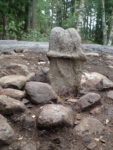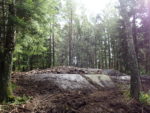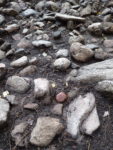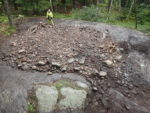 An impressively endowed stone in the shape of a penis has been unearthed at a Bronze Age site in Rollsbo near Gothenburg in western Sweden. Archaeologists were excavating the site in advance of planned industrial development in the area when they came across the stone. It is 20 inches high and while they are reluctant to call it a phallus at this early stage in the archaeological investigation, the penile anatomy is rendered in such unmistakable detail that whoever erected it had to have done so with symbolic purpose.
An impressively endowed stone in the shape of a penis has been unearthed at a Bronze Age site in Rollsbo near Gothenburg in western Sweden. Archaeologists were excavating the site in advance of planned industrial development in the area when they came across the stone. It is 20 inches high and while they are reluctant to call it a phallus at this early stage in the archaeological investigation, the penile anatomy is rendered in such unmistakable detail that whoever erected it had to have done so with symbolic purpose.
 When archaeologists began excavating the rock pile known as Ytterby 98, they thought it was a burial cairn not unlike the one in Gylland where the Roman bronze cauldron was recently unearthed. As they peeled back the layers, chains of placed stones appeared that are indeed similar to cairns, but one stone placed in the center did not fit the usual pattern. At first the team thought it was a paving stone. Additional excavation revealed the penis shape which is unique in this context.
When archaeologists began excavating the rock pile known as Ytterby 98, they thought it was a burial cairn not unlike the one in Gylland where the Roman bronze cauldron was recently unearthed. As they peeled back the layers, chains of placed stones appeared that are indeed similar to cairns, but one stone placed in the center did not fit the usual pattern. At first the team thought it was a paving stone. Additional excavation revealed the penis shape which is unique in this context.
 The monument dates to the Late Bronze Age (1100-500 B.C.) and was built up between two rocky outcroppings. On the south side the paving leads to a lower level basin also filled with stone that appears to have served as a formal entrance to the monument. To the north of the monument are moss fields. Facing the moss field near the phallic stone are two boulders that are part of the circular edge chain. Between them lies a small circular red stone. Because it is completely unlike all the other stones on the site, archaeologists believe it was deliberately placed there and held some special significance.
The monument dates to the Late Bronze Age (1100-500 B.C.) and was built up between two rocky outcroppings. On the south side the paving leads to a lower level basin also filled with stone that appears to have served as a formal entrance to the monument. To the north of the monument are moss fields. Facing the moss field near the phallic stone are two boulders that are part of the circular edge chain. Between them lies a small circular red stone. Because it is completely unlike all the other stones on the site, archaeologists believe it was deliberately placed there and held some special significance.
 Around the penis-shaped stone archaeologists unearthed five clearly defined layers of soot and carbonaceous materials mixed with stone. Two charred bones were found in one of the layers. These have yet to be analyzed, but are believed to be animal bones. Archaeologists hope that analysis of soil from the carbonaceous layer will find charred organic remains like seeds or plants that will be evidence of on-site burned offerings.
Around the penis-shaped stone archaeologists unearthed five clearly defined layers of soot and carbonaceous materials mixed with stone. Two charred bones were found in one of the layers. These have yet to be analyzed, but are believed to be animal bones. Archaeologists hope that analysis of soil from the carbonaceous layer will find charred organic remains like seeds or plants that will be evidence of on-site burned offerings.
 The stone was probably already reminscient of a penis naturally. Weathering and erosion had formed it into a recognizably phallic shape and then that shape was reinforced by carving. (The veins have to have been carved, right? I mean, damn.) Phallus form stones have been found before in prehistoric Sweden, particularly along important communication and trade routes, but this is the only one ever found at a likely sacrificial site. Given the context, archaeologists hypothesize that this site may have been associated with a fertility cult.
The stone was probably already reminscient of a penis naturally. Weathering and erosion had formed it into a recognizably phallic shape and then that shape was reinforced by carving. (The veins have to have been carved, right? I mean, damn.) Phallus form stones have been found before in prehistoric Sweden, particularly along important communication and trade routes, but this is the only one ever found at a likely sacrificial site. Given the context, archaeologists hypothesize that this site may have been associated with a fertility cult.